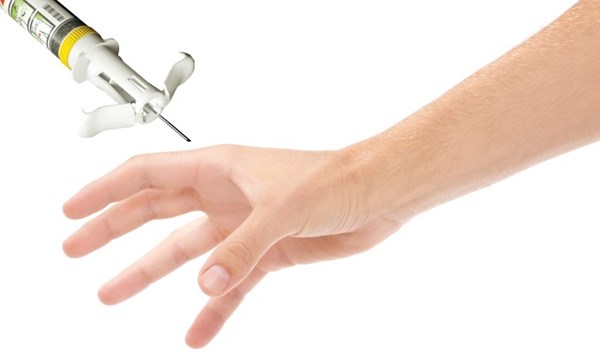Digital Ischemia to Fifth Digit from IM Epinephrine Successfully Treated With SQ Terbutaline
Introduction
Epinephrine autoinjectors are often prescribed for those at risk for anaphylaxis. A common occurrence with these autoinjectors is accidental injection into the wrist and hands. Although there are several occurrences of resultant digital ischemia, there are no standardized guidelines for management.
Presenting Concerns, Clinical Findings
A 13-year-old patient with a past medical history of asthma presented to the emergency department after accidental injection of an epinephrine autoinjector into his left hand. His sister had been teasing him prior to the event with the autoinjector, presuming it was a test pen, and proceeded to inject his hand with the pen. The patient stated that he felt immediate pain in the hand and started noticing that his fifth digit was beginning to turn “white” with reduced sensation.
On examination, the patient was alert and oriented; he appeared to be in minimal distress. Abnormal vital signs for the patient included tachycardia with an HR of 110 bpm and BP of 130/86 mmHg. Focused examination of the left hand revealed delayed capillary refill at the fifth digit, much greater than four seconds with sensation grossly intact, and notable whitish hue from the base of the left fifth digit extending to the tip. To the touch, his fifth digit was colder compared to the rest of his hand.
Patient Course
After the patient was roomed and underwent physical examination, the pharmacy was called for phentolamine for local injection in order to reduce the extent of digital ischemia from the epinephrine autoinjector. The pharmacy informed us that phentolamine was not available.
With additional research, the decision was made to use terbutaline as a second-line option to treat the patient’s digital ischemia. While waiting for the terbutaline to come from the pharmacy, nitroglycerin paste 2 percent was applied, but no improvement was noted after 20 minutes.
Terbutaline 0.25mg 1 mL was drawn up, placed in a 10 mL saline syringe, and injected into the base of the left fifth digit. Upon reassessment of the patient’s hand after 20 minutes, there was visible improvement in color with return of normal pigmentation, and capillary refill was <2 seconds. The patient was observed for another hour in the ED. There was no worsening of symptoms, and he was discharged home.
The following day the patient had an appointment with his pediatrician, who noted no abnormalities of his digit. A follow-up phone call was placed with his mother, who stated the patient had no complications.
Discussion
Epinephrine’s primary mechanism of action functions as an alpha- and beta-adrenergic agonist, which can lead to vasoconstriction and increased vascular resistance. This can be problematic if injected into the digits and can lead to digital ischemia. Some current recommendations for treatment of digital ischemia are:
- Phentolamine: Functions as an alpha-1-receptor antagonist leading to vasodilation. This would compete with epinephrine for these receptors.
- Topical Nitroglycerin: Nitroglycerin is a nitrate vasodilator and is metabolized into NO. Nitrite oxide has action on the vascular smooth muscles, which can cause arterial and vasodilation.
Conclusion
Digital ischemia after accidental injection of an epinephrine autoinjector can be treated with subcutaneous terbutaline injection. Terbutaline is a selective beta-2-agonist, resulting in vasodilation. This can help with digital ischemia by increasing blood flow and reducing tissue ischemia. For our patient, terbutaline worked more rapidly compared to topical nitroglycerin. We were able to return good flow to the patient’s finger and normalize capillary refill and color shortly after injecting terbutaline. Terbutaline is a good alternative to phentolamine for treatment of digital ischemia.
References
Aljahany MS, Aleid DK, Aal Ibrahim AM. Reversal of Digital Ischemia with Phentolamine After Accidental Epinephrine Injection. Am J Case Rep. 2020;21:e923877. Published 2020 Sep 14. doi:10.12659/AJCR.923877
Salman Ibn Mujtaba, MD; Aljoharah Alameel, MD; Bashayer Hamad, MD; Taimur Salar Butt, MD. Digital Ischemia From Accidental Epinephrine Injection. EMed Journal. 10.12788/emed.2018.0090. Published 2018 May.



